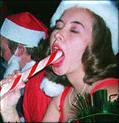
Build Date: Wed Dec 24 12:40:21 2025 UTC
OK. What part of "Blah blah, blah BLAH blah" did you people not understand?
-- P a u l
| Pagan Christmas -- Reported 1998-12-27 22:07 by Pao Tzu | |

|
Pao Tzu's Christmas essay comes in a few days late and a few dollars short. But, considering that no one else but he and Lenny submitted essays, he gets the 1st Runner-up prize in the Pigdog Journal Christmas Essay Contest. It's a travesty of justice, but what can you do? -- Ed. The Christmas holiday is an adaptation of the pagan winter solstice rites. Pagans in northwestern Europe conducted a yearly celebration which is remarkably similar to the Christmas we know today. There are key differences which I will attempt to enumerate in this essay. Most pagans lived together in small communities and/or nomadic groups which included all members of their family who were not married out to other communities. In many cases, these family groups were brought together by marriages resulting in common kin. In the western tradition of Christmas, families are scattered about with bookmakers taking long odds as to the probability that everyone will show up. The Christmas holiday is complicated by the exchange of presents which causes many family members not to participate because of their own cheapness. Gift giving among pagans was almost entirely mutual, utilitarian, and practical. Things commonly exchanged included livestock, lard, intoxicants, and wives. However, in the Western tradition, it is more common for family to give each other bulky items they know will be of absolutely no use. This is the case with beanie babies, furby, popcorn makers, preserved meats, and cars. More often than not, the western practice of gift giving ends with both sides feeling lousy as a result of the exchange. One side for giving too rich a gift, the other for a gift which was poor (i.e. Peter Vella.) Trees play an important role in the winter holidays. In pagan tradition, these trees were cut down for firewood and the sap which allowed people to paint their bodies with solanaceous plant extracts and dance in a dehydrated frenzy for hours on end. Christmas trees are also used for firewood but this is usually unintentional. A traditional pagan winter meal consists of very cheap but plentiful foodstuffs. Commonly used items are wild berries, mushrooms, and edible shrubs. The reason being that these small communities must eat very little of their staple goods as planting season is months away. Christmas meals usually consist of enough food to fill everyone who showed up as well as for everyone who didn't. This results in an overload of food, making everyone flatulent as well as lazy. Santa originates from the concept of "cinter claus," a scandanavian demi-god who led a pack of reindeer for the sole purpose of finding thieves, jumping them, and packing their stolen property into his gigantic sled. He commonly was aided by two or three thugs who painted their faces with soot in order shock potential targets. This myth was later translated by Americans into a fat man wearing red who dropped through chimneys and simply left things behind for those who were not thieves. Chakkahananuh, or however it is spelled, was invented by men with mutilated genitals in an attempt to stretch oil out as long as possible. Gifts are also exchanged during this holiday such as counterfeit diamonds. It is dissimilar from Christmas as everyone is not so encouraged to eat and drink themselves into oblivion. Most people who celebrate this variation of the winter solstice already live with their parents, grandparents, and possibly great-grandparents so there is no need for long-distance travel. |
T O P S T O R I E S
The Crossroads are real and The Blues is a place; The enduring myth of Robert Johnson (More...)
California Glory Hole attracts huge crowds
A glory hole at Napa's Lake Berryessa is drawing huge crowds. According to Chris Lee, the general manager for the Solano County Water Agency, the glory hole hasn't been active since 2019, and only restarted operations on Feb 4. (More...)
Republican State Senator busted after soliciting a teenage girl
Republican State Senator Justin Eichorn of Minnesota was arrested for soliciting a teen girl on Monday just hours after he introduced a bill proposing "Trump derangement syndrome" (TDS) as a form of mental illness. (More...)
Parents claim measles is not that bad after having only one child die
The parents of a Texas girl who died from the measles are defending their decision not to vaccinate their daughter. "She says they would still say 'Don't do the shots,'" an unidentified translator for the parents said. "They think it’s not as bad as the media is making it out to be." (More...)
Delusional rich man tries to fire town staff
"I'm mayor now" said write-in mayoral candidate and founder of Pirate’s Booty Snacks Robert Ehrlich after losing the election for Mayor of Sea Cliff, NY. Then he tried to take over the Village Hall and fire everyone. (More...)
Musk claims Xitter security is staffed by idiots
Earlier this month Xitter experienced a massive outage. In an interview, Musk told Fox Business that he believes the attack came from "IP addresses originating in the Ukraine area." (More...)
C L A S S I C P I G D O G
Place the Lighter on the Ground and Let Us See Your Hands
So I have been thinking on this whole flag burning issue and all the things it could imply. Now a lot of people right now are saying that there are more important issues at stake and something so trivial is a waste of time. Believing such is really losing sight of some very key changes happening in our nation right now. Being a strict conservative, and currently serving in Iraq, I was surprised to find that I am actually appalled that the House approved a ban on flag burning. (More...)
It's winter in Idaho, and Boise personality "Lego-Man" reports on how he celebrated Thanksgiving. "I fed my wife, mother and sister wine slurpies!" (More...)
Paranoid Strippers & Psychotic Crack Dealers (Tales of Christmas Eve)
Christmas day, for the last 17 or so years has bored me. I find that the real fun and excitement always takes place on Christmas Eve. Every other year, it's the excitement of the metaphorical hunt instead of the kill. Otherwise, it's just plain bad craziness. (More...)
The Deep Dark Underbelly of the Star Wars Myth, or Ramayana Remembered
It's a fact: Star Wars is a blatant plagiarism of an ancient Asian legend, and the long lines of devout Star Wars freaks are really unscrupulous Asian copyright busters. From Indonesia to Thailand to Nepal, videos are available for sale or rent before they're even released in the US and UK due to this nerdy camcorder-clutching bunch. (More...)
Grow better illegal mushrooms than lousy "Psilocybe fanaticus"
Disclaimer: PaoTzu's a1 illegal mushroom cultivation cookbook is meant for educational purposes only. Be aware of the techniques used by hardcore criminals! Protect your children! Read, learn, educate. Do not try this at home. (More...)
Our man Daemon Agent checks out the heavy heavy sounds of crazy space surf rockers Man or Astroman?. (More...)


